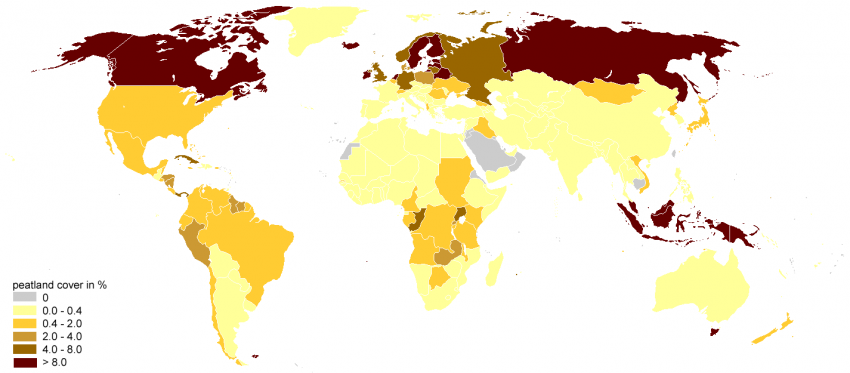What is the issue?
Peatlands are a type of wetland which occur in almost every country and are known to cover at least 3% of global land surface. The term ‘peatland’ refers to the peat soil and the wetland habitats growing on the surface.

Peatlands are a type of wetland which occur in almost every country and are known to cover at least 3% of global land surface. The term ‘peatland’ refers to the peat soil and the wetland habitats growing on the surface.

Estimated global distribution of peatlands
In peatlands, year-round water-logged conditions slow plant decomposition to such an extent that dead plants accumulate to form peat. This stores the carbon the plants absorbed from the atmosphere within peat soils, providing a net-cooling effect and helping to mitigate the climate crisis.
Peatland landscapes are varied: from temperate blanket mires with open, treeless vegetation such as the Flow Country of Scotland to swamp forests in Southeast Asia. New areas are still being discovered. The world’s largest tropical peatland was identified beneath the forests of the Congo Basin in 2017.
Degradation and overexploitation of peatland landscapes release huge quantities of greenhouse gasses.
This results mainly from a lack of awareness of the benefits of peatlands and includes actions such as: drainage, conversion for agriculture, burning, and mining for fuel. In some regions, up to 80% of peatlands have been damaged.
Peatlands are significant to global efforts to combat climate change and achieve other Sustainable Development Goals. Their protection and restoration are vital in the transition to a zero-carbon society.
Emissions from drained peatlands are estimated at 1.9 gigatonnes of CO2e annually. This is equivalent to 5% of global anthropogenic greenhouse gas emissions, a disproportionate amount considering damaged peatlands cover just 0.3% of landmass. Fires in Indonesian peat swamp forests in 2015, for example, emitted nearly 16 million tonnes of CO2 a day; which is more than the entire economy of the United States.
Worldwide, the remaining area of near natural peatland (over 3 million km2) sequesters 0.37 gigatonnes of CO2 a year. Peat soils contain more than 600 gigatonnes of carbon which represents up to 44% of all soil carbon, and exceeds the carbon stored in all other vegetation types including the world’s forests.
In their natural, wet state, peatlands provide indispensable Nature-based Solutions for adapting to and mitigating the effects of climate change, including regulating water flows, minimising the risk of flooding and drought, and preventing seawater intrusion. Wet peatlands lower ambient temperatures in surrounding areas, providing refuge from extreme heat, and are less likely to burn during wildfires. This helps to preserve air quality.
Draining peatlands reduces the quality of drinking water as water becomes polluted with organic carbon and pollutants historically absorbed within peat.
In many parts of the world, peatlands supply food, fibre and other local products that sustain economies. They also preserve important ecological and archaeological information such as pollen records and human artefacts.
Damage to peatlands causes biodiversity loss. For example, the decline of the Bornean orang-utan population by 60% within 60 years is largely attributed to the loss of peat swamp habitat. The species is now listed as Critically Endangered on The IUCN Red List of Threatened Species™.
Urgent action worldwide to protect, sustainably manage, and restore peatlands is essential.
This involves stopping degrading activities such as agricultural conversion and drainage, and restoring the waterlogged conditions required for peat formation. Data shows that this is the only land-based option to indefinitely sequester carbon, is cost-effective, and that any emissions from restoration are more than offset in the long-term.
Clear and ambitious targets for the rewetting and restoration of peatlands must be set (such as those in the UK and Association of Southeast Asian Nations country strategies), and peatland protection included in national adaptation plans to meet commitments under the Paris Agreement.
The definition of peatlands varies between countries, and often excludes areas of value to industry. Given the urgent need to reduce greenhouse gas emissions and prevent biodiversity loss, definitions of peatlands should prioritise conservation, restoration and sustainable management.
Public and private finance must be mobilised to secure peatlands and provide green jobs. Possible instruments include: emissions trading schemes and carbon markets; investment in restoration through payment for ecosystem services (such as clean water and flood protection); environmental bonds; government-backed carbon price guarantees.
The international community, including the UN Environment Programme, Food and Agriculture Organization and Ramsar Convention, have already committed to several goals, resolutions and strategic actions.
These include: assessing the distribution and state of peatlands globally; measuring and reporting emissions from peatlands; protecting and restoring peatlands with targeted investments; stimulating market-based mechanisms to support peatlands; engaging and supporting local communities to manage peatlands sustainably and overcome associated costs; sharing expertise and experience on peatland conservation, restoration and improved management. These efforts must continue.

Peat bog in the High Fens reserve, Belgium
IUCN recommends (WCC 2016 Res 043) that peatlands be included alongside forests in all relevant intergovernmental agreements relating to climate change, geodiversity and biodiversity.
IUCN Members also call for a moratorium on peat exploitation until legislation is strengthened to ensure peatlands are managed sustainably.
Emissions from damaged peatlands and carbon savings from peatland restoration are eligible for national accounting under the UN Framework Convention on Climate Change. Governments can therefore include peatland restoration and re-wetting in national climate action plans.